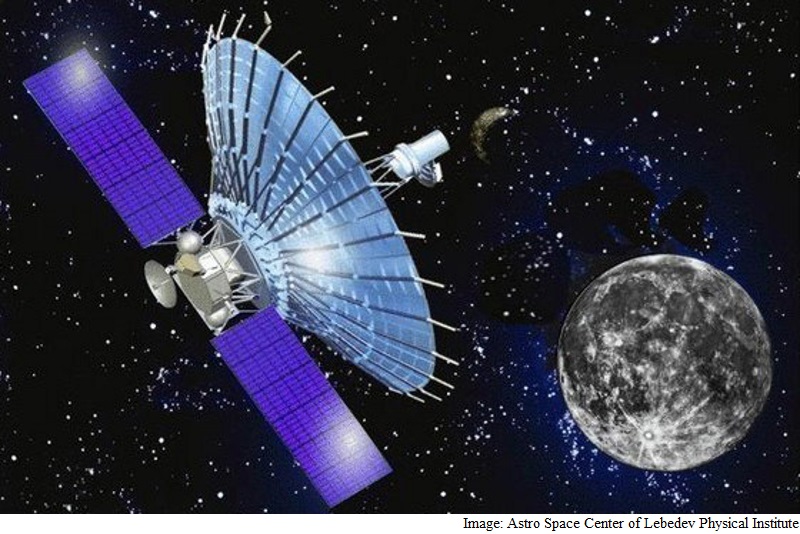- Home
- Science
- Science News
- Virtual Earth Space Telescope Reveals New Details About the Milky Way
Virtual Earth-Space Telescope Reveals New Details About the Milky Way

The researchers were surprised when their Earth-space system revealed a temperature hotter then 10 trillion degrees.
"Only this space-Earth system could reveal this temperature, and now we have to figure out how that environment can reach such temperatures," said Yuri Kovalev, the RadioAstron project scientist.
"This result is a significant challenge to our current understanding of quasar jets," he added.
Using an orbiting radio telescope in conjunction with four ground-based radio telescopes, the team achieved the highest resolution of any astronomical observation ever made.
The feat produced a pair of scientific surprises that promise to advance the understanding of quasars, supermassive black holes at the cores of galaxies.
The scientists combined the Russian RadioAstron satellite with the ground-based telescopes to produce a virtual radio telescope.
They pointed this system at a quasar called 3C 273, more than two billion light-years from Earth.
Quasars like 3C 273 propel huge jets of material outward at speeds nearly that of light. These powerful jets emit radio waves.
The observations also showed, for the first time, substructure caused by scattering of the radio waves by the tenuous interstellar material in our own Milky Way Galaxy.
"This is like looking through the hot, turbulent air above a candle flame," added Michael Johnson from the Harvard-Smithsonian Center for Astrophysics.
"We had never been able to see such distortion of an extragalactic object before," he noted in a paper appeared in Astrophysical Journal Letters.
The amazing resolution from RadioAstron working with the ground-based telescopes gives scientists a powerful new tool to explore not only the extreme physics near the distant supermassive black holes but also the diffuse material in our home galaxy.
The RadioAstron satellite was combined with the Green Bank Telescope in West Virginia, The Very Large Array in New Mexico, the Effelsberg Telescope in Germany, and the Arecibo Observatory in Puerto Rico.
Signals received by the orbiting radio telescope were transmitted to an antenna in Green Bank where they were recorded and then sent over the internet to Russia.
Here, they were combined with the data received by the ground-based radio telescopes to form the high resolution image of 3C 273.
Catch the latest from the Consumer Electronics Show on Gadgets 360, at our CES 2026 hub.
Related Stories
- Samsung Galaxy Unpacked 2025
- ChatGPT
- Redmi Note 14 Pro+
- iPhone 16
- Apple Vision Pro
- Oneplus 12
- OnePlus Nord CE 3 Lite 5G
- iPhone 13
- Xiaomi 14 Pro
- Oppo Find N3
- Tecno Spark Go (2023)
- Realme V30
- Best Phones Under 25000
- Samsung Galaxy S24 Series
- Cryptocurrency
- iQoo 12
- Samsung Galaxy S24 Ultra
- Giottus
- Samsung Galaxy Z Flip 5
- Apple 'Scary Fast'
- Housefull 5
- GoPro Hero 12 Black Review
- Invincible Season 2
- JioGlass
- HD Ready TV
- Laptop Under 50000
- Smartwatch Under 10000
- Latest Mobile Phones
- Compare Phones
- Infinix Note Edge
- Lava Blaze Duo 3
- Tecno Spark Go 3
- iQOO Z11 Turbo
- OPPO A6c
- Samsung Galaxy A07 5G
- Vivo Y500i
- OnePlus Turbo 6V
- Lenovo Yoga Slim 7x (2025)
- Lenovo Yoga Slim 7a
- Lenovo Idea Tab Plus
- Realme Pad 3
- Garmin Quatix 8 Pro
- NoiseFit Pro 6R
- Haier H5E Series
- Acerpure Nitro Z Series 100-inch QLED TV
- Asus ROG Ally
- Nintendo Switch Lite
- Haier 1.6 Ton 5 Star Inverter Split AC (HSU19G-MZAID5BN-INV)
- Haier 1.6 Ton 5 Star Inverter Split AC (HSU19G-MZAIM5BN-INV)







![[Sponsored] Haier C90 OLED TV | Dolby Vision IQ, 144Hz OLED and Google TV in Action](https://www.gadgets360.com/static/mobile/images/spacer.png)









